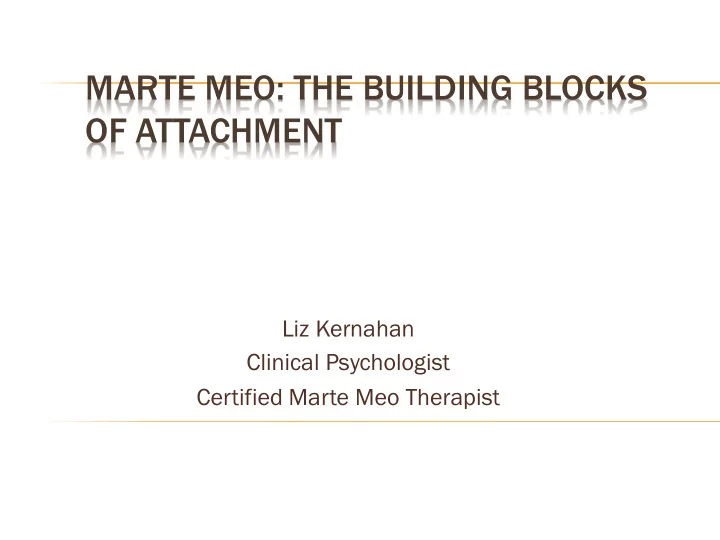

MARTE MEO: THE BUILDING BLOCKS OF ATTACHMENT Liz Kernahan Clinical Psychologist Certified Marte Meo Therapist
INTRODUCTION: MARTE MEO The aim of this presentation is to introduce 4 fundamental principles of Marte Meo and demonstrate these using video footage. What is Marte Meo? Ò Marte Meo : Translated from Latin means “on one’s own strength”. The idea of supporting children to find their own strength is an important concept when working with children. Ò Marte Meo is a method which focuses on the importance of communication in the building of relationships and emotional connections. It is the “the how to” of attachment. Ò Marte Meo was devised by Maria Aarts in Holland through the 1970s and 80’s. Developed first through Maria’s work with children with Autism. It has broad applicability including carers in elder care settings.
PREVIEW: 4 PRINCIPLES OF MARTE MEO Ò Principle 1: Give children a good face and good tones. Ò Principle 2: Follow and name children’s initiatives in play or conversation. Ò Principle 3: Name what you are doing. Ò Principle 4: Name the child’s internal/ emotional experience.
PRINCIPLE 1. GIVE A NICE FACE AND NICE TONE Ò This is the most simplest yet most important principle in Marte Meo. Ò A quick exercise…. Ò Children can read the communication intention in your face and tone. Innate learning. Ò When we give a child or children a good face and positive tones we: Ò 1. Create a good atmosphere and set a positive learning environment. Ò 2. Sends the message to the child “you are liked”… “you are OK!”. They feel valu lued a and nd c conf nfident nt
PRINCIPLE 2: FOLLOW & NAME THE CHILD’S INITIATIVE Ò This is another very important Marte Meo principle which you can use in every day situations. Ò We know children learn through play and that play is critical to their global development. Ò When children are looking at something or engaged with something their brains are most active and they are able to take on new words, especially when you say it with warm, interested or emotional tones. Ò By following the child’s actions and naming what they are doing while they are doing it, it sends the message to the child…
P2. FOLLOW AND NAME..CONTINUED…. Ò 1. You are interested in them and connected with them - and this adds to their sense of security and builds the relationship with you.. Ò 2. It helps them to develop language connected to their actions. Ò 3. It helps them stay focused on the activity Ò 4. It helps them register their body movements and develop self registration. They learn self regulation.
PRINCIPLE 3: NAME WHAT YOU ARE DOING Ò In everyday moments naming what you are doing is yet another simple action which will help build the learning environment and the relationship with the children. Ò When you name what you are doing for children : 1. It is respectful – it sends the message to the child that you are aware of their presence and that they are considered. 2. It makes you predictable, and this makes children feel safe and secure in the environment and with you – they are kept “in the loop” with you.
P3: NAME WHAT YOU ARE DOING, CONT… Ò 3. When you name what you are doing it models this behaviour for children. They will then name what they are doing -this develops their social skills.
PRINCIPLE 4. NAME THE CHILD’S EMOTIONAL / INTERNAL EXPERIENCE Ò Another important principle for building the attachment relationship through communication is naming the child’s emotional experience. This is particularly important for children who have behavioural or emotional difficulties. Ò When you name how they are feeling, what they are thinking or what they like, or what they are noticing: 1. It sends the message to the child that you are emotionally connected to them and understand them and they are not alone. Important when feeling big emotions. 2. It helps them develop words for their emotional or inner experiences. 3. It helps them register and connect with their body.
SUMMARY Ò The 4 principles of Marte Meo: help to building attachment relationships, by enhancing respectful communication & this helps children feel valued. Ò Summary: 1: good face and nice tone in setting the relationship tone and the learning environment. Builds self confidence. 2: following and naming a child initiatives – supports the emotional connection, gives language, supports creative play, focus, self confidence & self regulation. 3: Naming what we are doing: to promote predictability and co-operation – keeps the child in the loop, as well as modeling pro-social behaviour. 4: Naming the child’s internal experiences : supports emotional connection, development of language connected to feelings, the development of self registration and regulation. = The child on the leading slide.
Recommend
More recommend